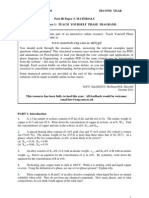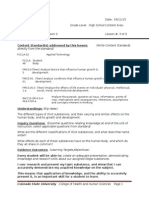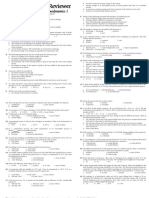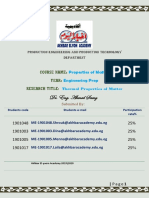Chemistry 201 Phase Change Role Play
Chemistry 201 Phase Change Role Play
Uploaded by
api-295429241Copyright:
Available Formats
Chemistry 201 Phase Change Role Play
Chemistry 201 Phase Change Role Play
Uploaded by
api-295429241Original Title
Copyright
Available Formats
Share this document
Did you find this document useful?
Is this content inappropriate?
Copyright:
Available Formats
Chemistry 201 Phase Change Role Play
Chemistry 201 Phase Change Role Play
Uploaded by
api-295429241Copyright:
Available Formats
STEPP Lesson Plan Form
Teacher: Austin Dicken
11-27-16
School:
8th
Prairie Heights Middle School
Content Area:
Date:
Grade Level:
Title: Phase Change Role Play
Lesson #:_1_ of _1_
Content Standard(s) addressed by this lesson:
(Write Content Standards
th
directly from the standard)
6 Grade Science Standard 1.3: The physical
characteristics and changes of solid, liquid, and gas states can be explained using
the particulate model
Understandings: (Big Ideas)
Matter in the solid state has a fixed volume and its molecules/compounds/atoms are
fixed in space
Matter in the liquid state has a fixed volume and its molecules/compounds/atoms
move freely
Matter in the gaseous state does not have a fixed volume and its
molecules/compounds/atoms move freely to adapt to its container
Inquiry Questions: (Essential questions relating knowledge at end of the unit of
instruction, select applicable questions from standard)
Describe the molecules of a solid, liquid, and gas referring to volume, shape, and
frequency of collisions.
Evidence Outcomes: (Learning Targets)
Every student will be able to: work with their group to role play a phase change
of matter given their phase change of matter, a definition of their phase change of
matter, examples of their phase change of matter, and figures of how the molecules
are arranged before and after their phase change of matter has occurred with 100%
accuracy
I can: work with my group to role-play our groups phase change of matter
in front of the class
This means: students will have to work with a group of peers to role play a
chosen phase change of matter from the standpoint of their bodies being
the molecules in their solids, liquids, and gasses
List of Assessments: (Write the number of the learning target associated with
each assessment)
Colorado State University College of Applied Human Sciences
Page 1
STEPP Lesson Plan Form
Formative Verbal questioning during do now and role-play activity, visual
observations for correctness during do now and for correctness of molecules during
role-play activity, fist to five closure
Summative correct answers given during do now, graphic organizer filled out with
correct phase changes of matter during role-play activity
Colorado State University College of Applied Human Sciences
Page 2
STEPP Lesson Plan Form
Planned Lesson Activities
Name and Purpose of Lesson
Should be a creative title for you and the
students to associate with the activity.
Think of the purpose as the mini-rationale
for what you are trying to accomplish
through this lesson.
Approx. Time and Materials
How long do you expect the activity to
last and what materials will you need?
Phase Change of Matter Role Play
Anticipatory Set
The hook to grab students attention.
These are actions and statements by the
teacher to relate the experiences of the
students to the objectives of the lesson,
To put students into a receptive frame of
mind.
To focus student attention on the
lesson.
To create an organizing framework
for the ideas, principles, or
information that is to follow
(advanced organizers)
An anticipatory set is used any time a
different activity or new concept is to be
introduced.
Do Now Identify if the following statements are true or false:
1. Solids have a definite shape and a definite volume
2. Liquids have a definite shape and do not have a definite volume
3. Gasses do not have a definite shape and do not have a definite
volume
Introduction who can relate todays do now to the molecules in solids,
liquids, and gasses using examples? for example, solids have a fixed
volume and fixed shape which means that the molecules in a solid are
tightly packed together so that they cannot move and change the
overall shape of the solid. For example, liquids molecules are far
enough away from each other to be able to shift and move around each
other in order to change the shape of the overall liquid. However, the
liquids molecules are close enough together to make any liquids
volume definite. For example, gasses have an indefinite volume and
shape because the molecules in a gas are very far apart allowing them
to move past one another and be compressed together. Properties
such as volume and shape change as phases of matter change. What is
the driving force that causes phases of matter to change thus changing
properties of the matter? The addition and subtraction of energy
Purpose to build collaboration skills while digging deeper into the
movement and placement of molecules before, during, and after a
phase change of matter occurs
Do Now (7 min) projector, agenda document, white board, computer,
role sheet, running do now sheet, writing utensils, dry erase marker
Introduction (8 min) role play activity table for every student, 6 plastic
bags, 6 note cards with phase change of matter information, group
assignments, instructions for role play activity, agenda document
Role Play Activity (35 min) 6 plastic bags with phase change of matter
assignments and information, role play activity table for every student,
writing utensils
Colorado State University College of Applied Human Sciences
Page 3
STEPP Lesson Plan Form
Procedures
(Include a play-by-play account of what
students and teacher will do from the
minute they arrive to the minute they
leave your classroom. Indicate the length
of each segment of the lesson. List actual
minutes.)
Indicate whether each is:
-teacher input
-modeling
-questioning strategies
-guided/unguided:
-whole-class practice
-group practice
-individual practice
-check for understanding
-other
Closure
Those actions or statements by a teacher
that are designed to bring a lesson
presentation to an appropriate conclusion.
Used to help students bring things
together in their own minds, to make
sense out of what has just been taught.
Any Questions? No. OK, lets move on is
not closure. Closure is used:
To cue students to the fact that
they have arrived at an important
point in the lesson or the end of a
lesson.
causes matter to change its phase. Today we are going to play the
role of the molecules in a solid, liquid, and gas in order to show how
they move and are arranged through a role play activity. The teacher
will then introduce the rules and expectations of the role-play activity
making sure students have time to ask any questions or request
clarification.
Do Now students will answer the do now on a running do now sheet,
while the teacher takes role and answers any questions about the do
now. The first student done will also stamp other students do now
sheets based on if they are doing the do now or if they are not doing
the do now
Introduction students actively listen, answer questions, and ask
questions, while the teacher links the do now to the particulate model
and molecules in solids, liquids, and gasses
Role Play Activity students work in groups to come up with their skit,
while the teacher answers questions and helps guide the groups to the
correct arrangement and spacing of the molecules for their skit. The
students will then perform their skit, while the spectating students use
clues during the skit to figure out what phase change of matter each
group has. The teacher will help guide students to the correct answers
between each skit.
Fist to five in order to figure out if students need extra help with phase
changes of matter and properties of solids, liquids, and gasses during
the test review on Wednesday
Colorado State University College of Applied Human Sciences
Page 4
STEPP Lesson Plan Form
To help organize student learning
To help form a coherent picture and to
consolidate.
Differentiation
To modify: If the activity is too advanced
for a child, how will you modify it so that
they can be successful?
To extend: If the activity is too easy for a
child, how will you extend it to develop
their emerging skills?
Assessment
How will you know if students met the
learning targets? Write a description of
what you were looking for in each
assessment.
To Modify students are placed in specific groups in order to insure
success, activity is visual, activity is collaborative, activity has hands on
portions
To Extend activity has a part that is done alone, students are placed
in specific groups in order to insure success
Formative looking for understanding of particulate model and
properties of solids, liquids, and gases
Summative looking for the correct answers when guessing what
phase change of matter each group has
Colorado State University College of Applied Human Sciences
Page 5
STEPP Lesson Plan Form
Post Lesson Reflection
1. To what extent were lesson objectives achieved? (Utilize
assessment data to justify your level of achievement)
2. What changes, omissions, or additions to the lesson would
you make if you were to teach again?
3. What do you envision for the next lesson? (Continued practice,
reteach content, etc.)
Colorado State University College of Applied Human Sciences
Page 6
You might also like
- Second Grade Science LessonDocument15 pagesSecond Grade Science Lessonlionheart10131333% (3)
- 5e Lesson Planning Template Danielle CarpenterDocument8 pages5e Lesson Planning Template Danielle Carpenterapi-559019570No ratings yet
- Properties of Matter Introduction Lesson PlanDocument6 pagesProperties of Matter Introduction Lesson Planapi-497368912No ratings yet
- !!!! 2014-NGSTech-Proceedings PDFDocument119 pages!!!! 2014-NGSTech-Proceedings PDFMateusz SynowieckiNo ratings yet
- Mech HeatTransfer 15.0 L07 TransientThermalDocument30 pagesMech HeatTransfer 15.0 L07 TransientThermalpercys99No ratings yet
- TYPD ExercisesDocument10 pagesTYPD ExercisesConstance Lynn'da GNo ratings yet
- Best Practices For Modeling Multi Phase Flows in Automotive IndustryDocument55 pagesBest Practices For Modeling Multi Phase Flows in Automotive Industryamir_chemeng100% (1)
- WeeblylpDocument3 pagesWeeblylpapi-240749120No ratings yet
- Reflective Lesson Plan-ScienceDocument12 pagesReflective Lesson Plan-Scienceapi-242013201No ratings yet
- States of Matter Lesson PlanDocument4 pagesStates of Matter Lesson Planapi-542026563No ratings yet
- Lesson Plan Revison LLTDocument4 pagesLesson Plan Revison LLTapi-237660366No ratings yet
- Unit Overview Ees440Document4 pagesUnit Overview Ees440api-294097634No ratings yet
- Lesson Plan-Educ 1070-3 Mckenna CorinneDocument6 pagesLesson Plan-Educ 1070-3 Mckenna Corinneapi-242280098No ratings yet
- 5e Lesson Planning Template-1Document5 pages5e Lesson Planning Template-1api-708046935No ratings yet
- Lesson Plan 2Document2 pagesLesson Plan 2api-425043985No ratings yet
- Lesson 2 450Document7 pagesLesson 2 450api-257595875No ratings yet
- Lesson Plan - 1Document5 pagesLesson Plan - 1api-286837832No ratings yet
- Scavenger Hunt Lesson PlanDocument3 pagesScavenger Hunt Lesson Planapi-258318298No ratings yet
- Course: General Methods of Teaching: Code: 8601 Semester: Spring, 2021 Assignment # 2 Level: B.ed 1.5Document27 pagesCourse: General Methods of Teaching: Code: 8601 Semester: Spring, 2021 Assignment # 2 Level: B.ed 1.5irfan100% (1)
- Detailed Full Lesson PlanDocument6 pagesDetailed Full Lesson Planapi-234333471No ratings yet
- Connected Inquiry Lesson PortfolioDocument17 pagesConnected Inquiry Lesson Portfolioapi-309448541No ratings yet
- Wbi Teacher Guide 2013 Revised-1Document11 pagesWbi Teacher Guide 2013 Revised-1api-240341792No ratings yet
- Science Lesson ObservationDocument4 pagesScience Lesson Observationapi-450830120No ratings yet
- 442c Lesson Plan 4Document5 pages442c Lesson Plan 4api-299170197No ratings yet
- Epse 408 Unit PlanDocument5 pagesEpse 408 Unit Planapi-251031883No ratings yet
- Lesson Plan (Primary)Document6 pagesLesson Plan (Primary)api-294986516No ratings yet
- Kirsten Koyle Grade 5 Science and Technology Understanding Matter and EnergyDocument10 pagesKirsten Koyle Grade 5 Science and Technology Understanding Matter and Energyapi-311535995No ratings yet
- Unit Outline Template: Grade Subject: TitleDocument3 pagesUnit Outline Template: Grade Subject: TitleTyrea PriceNo ratings yet
- Denisbaik Science Rootbeerfloat Lesson2unitDocument4 pagesDenisbaik Science Rootbeerfloat Lesson2unitapi-317153463No ratings yet
- Unit PlanDocument45 pagesUnit Plannjc72832100% (1)
- Hardin County High School Lesson Plan FormDocument7 pagesHardin County High School Lesson Plan FormmagiclcjNo ratings yet
- Dbaik Sciencelesson SolidsliquidsgasesDocument4 pagesDbaik Sciencelesson Solidsliquidsgasesapi-317153463No ratings yet
- ClaylpDocument4 pagesClaylpapi-264808176No ratings yet
- Argumentation EquilibriumDocument7 pagesArgumentation Equilibriumapi-308996362No ratings yet
- States of Matter LessonDocument4 pagesStates of Matter Lessonapi-2526357270% (1)
- Mini-Unit Lesson PlanDocument17 pagesMini-Unit Lesson Planapi-335842932No ratings yet
- Columbus Lesson PlanDocument8 pagesColumbus Lesson Planapi-310437278No ratings yet
- Science Udl Lesson 1Document5 pagesScience Udl Lesson 1api-238637442100% (1)
- Devens SciencelpDocument5 pagesDevens Sciencelpapi-282221666No ratings yet
- Angela Tortora 5th Grade Why Does Matter Matter Lesson PlanDocument5 pagesAngela Tortora 5th Grade Why Does Matter Matter Lesson Planapi-262598106No ratings yet
- II ChangesinstatesDocument6 pagesII Changesinstatesapi-279609143No ratings yet
- Examine, Evaluate, Question, and Ethically Use Information From A Variety of Sources and Media To Investigate Ecosystem InteractionsDocument6 pagesExamine, Evaluate, Question, and Ethically Use Information From A Variety of Sources and Media To Investigate Ecosystem Interactionsapi-356824125No ratings yet
- 3 3 How Solids Liquid and Gases BehaveDocument4 pages3 3 How Solids Liquid and Gases Behaveapi-225070478100% (1)
- Lesson 3 96Document2 pagesLesson 3 96api-215458326No ratings yet
- Lesson Plan 3f 2Document9 pagesLesson Plan 3f 2api-340436002No ratings yet
- SciencelpDocument8 pagesSciencelpapi-270987649No ratings yet
- Web 2.0 Communcation and CollaborationTools) LESSON IDEA TEMPLATEDocument4 pagesWeb 2.0 Communcation and CollaborationTools) LESSON IDEA TEMPLATEstephaniespowerNo ratings yet
- Stepp Review Activity 1Document6 pagesStepp Review Activity 1api-281839323No ratings yet
- Matter Unit PlanDocument8 pagesMatter Unit Planapi-271760348100% (1)
- Diversity LessonDocument5 pagesDiversity Lessonapi-254206113No ratings yet
- Class: Biology Grade: 9th or 10th Unit: Anatomy and Function I. Student GoalsDocument8 pagesClass: Biology Grade: 9th or 10th Unit: Anatomy and Function I. Student GoalsHugunin42No ratings yet
- Zol Stav Kahn Term III Science LessonDocument6 pagesZol Stav Kahn Term III Science Lessonapi-273749995No ratings yet
- Lessonplan 1Document6 pagesLessonplan 1api-332892883No ratings yet
- Stages of MatterDocument3 pagesStages of Matterapi-704453652No ratings yet
- FSA Department UDL Lesson Plan FormatDocument4 pagesFSA Department UDL Lesson Plan Formatapi-623580840No ratings yet
- Schellenberg Portfolio 4 Di Strategies Science LessonDocument4 pagesSchellenberg Portfolio 4 Di Strategies Science Lessonapi-240543137No ratings yet
- Cellular Transport HomeworkDocument8 pagesCellular Transport Homeworkafmtioefb100% (1)
- Lesson Plan Format For Teacher Education Candidates Ithaca College School of Humanities and SciencesDocument5 pagesLesson Plan Format For Teacher Education Candidates Ithaca College School of Humanities and Sciencesapi-285942234No ratings yet
- Lesson To Be Taught FinalDocument4 pagesLesson To Be Taught Finalapi-283201273No ratings yet
- CEP Lesson Plan Form: Colorado State University College of Health and Human Sciences Page 1Document6 pagesCEP Lesson Plan Form: Colorado State University College of Health and Human Sciences Page 1api-279610141No ratings yet
- Unit Overview FinalDocument3 pagesUnit Overview Finalapi-284206763No ratings yet
- NST Lesson PlanDocument3 pagesNST Lesson PlansnespellmanNo ratings yet
- Biome Lesson PlanDocument4 pagesBiome Lesson PlanPamela IreneNo ratings yet
- Reflection 1Document1 pageReflection 1api-295429241No ratings yet
- Coke and MentosDocument6 pagesCoke and Mentosapi-295429241No ratings yet
- Name: - Date: - PeriodDocument1 pageName: - Date: - Periodapi-295429241No ratings yet
- Cndriveanail 54 WithimagesDocument3 pagesCndriveanail 54 Withimagesapi-295429241No ratings yet
- Name: - Date: - PeriodDocument1 pageName: - Date: - Periodapi-295429241No ratings yet
- Materials of Science and Structure of Matter - Section of The FE Supplied-Reference Handbook - NCEESDocument4 pagesMaterials of Science and Structure of Matter - Section of The FE Supplied-Reference Handbook - NCEESjazz fraire bernalNo ratings yet
- Module Shs Chem1Document4 pagesModule Shs Chem1Ansel SotnasNo ratings yet
- Separation of A MixtureDocument6 pagesSeparation of A MixtureSetya Ika Ika LestariNo ratings yet
- Unit PlanDocument22 pagesUnit Planapi-548036041No ratings yet
- Seal Qualification TestDocument25 pagesSeal Qualification TestvigneshNo ratings yet
- Sizing of Relief Valves For Two-Phase Flow in The Bayer ProcessDocument11 pagesSizing of Relief Valves For Two-Phase Flow in The Bayer Processjonyboy_1234915100% (1)
- Low Viscosity Monoglyceride-Based Drug Delivery Systems Transformed Into A Highly Viscous Cubic PhaseDocument10 pagesLow Viscosity Monoglyceride-Based Drug Delivery Systems Transformed Into A Highly Viscous Cubic Phasehitomi furugawaNo ratings yet
- Hot StampingDocument7 pagesHot Stampingakash.vd.1603No ratings yet
- Liquid-Liquid Extraction With Ternary Systems: 8.0 Instructional ObjectivesDocument22 pagesLiquid-Liquid Extraction With Ternary Systems: 8.0 Instructional ObjectivesLuis Puga CordovaNo ratings yet
- Phase Transition-HarvardDocument17 pagesPhase Transition-HarvardSawon KhanNo ratings yet
- Grain Refinement of AluminiumDocument12 pagesGrain Refinement of AluminiumRicha TripathiNo ratings yet
- CALPHAD: Computer Coupling of Phase Diagrams and ThermochemistryDocument19 pagesCALPHAD: Computer Coupling of Phase Diagrams and ThermochemistryDaniel J TraEsNo ratings yet
- Thermo PDFDocument129 pagesThermo PDFbansallove2008No ratings yet
- Eutectic System PDFDocument2 pagesEutectic System PDFTonyNo ratings yet
- 122 Finals ReviewerDocument12 pages122 Finals ReviewerLester Jason T. ChengNo ratings yet
- Clinker Formation ConceptsDocument28 pagesClinker Formation ConceptspashaNo ratings yet
- (1987 England Et Al.) The Movement and Entrapement of Petroleum Fluids in The SubsurfaceDocument21 pages(1987 England Et Al.) The Movement and Entrapement of Petroleum Fluids in The SubsurfaceAiwarikiaarNo ratings yet
- LLEDocument29 pagesLLEnandini100% (2)
- Curtis Petroleum Reservoir Fluid PropertiesDocument6 pagesCurtis Petroleum Reservoir Fluid Propertiesbenjamin kenyeryNo ratings yet
- Elementary Education: Science (5005) - Form 3Document10 pagesElementary Education: Science (5005) - Form 3Gim ReyesNo ratings yet
- Polycope MDF VFDocument2 pagesPolycope MDF VFElla KabongoNo ratings yet
- 1.Dr - Ahmed Samy - PhysicsDocument21 pages1.Dr - Ahmed Samy - PhysicsKhaled AhmedNo ratings yet
- Engineering Thermodynamics - Rwanda PolytechnicsDocument78 pagesEngineering Thermodynamics - Rwanda PolytechnicsAlexis MUHIRWANo ratings yet
- Chemical Engineering GATE 1999Document13 pagesChemical Engineering GATE 1999Anonymous 8pCXXsNo ratings yet
- CFX Multiphase 14.5 L10 Multicomponent Multiphase FlowsDocument14 pagesCFX Multiphase 14.5 L10 Multicomponent Multiphase FlowsedersalcedocastroNo ratings yet
- Lesson 5 - Spontaneous and Non-Spontaneous Process and EntropyDocument2 pagesLesson 5 - Spontaneous and Non-Spontaneous Process and EntropyJeff ValdezNo ratings yet






























































































